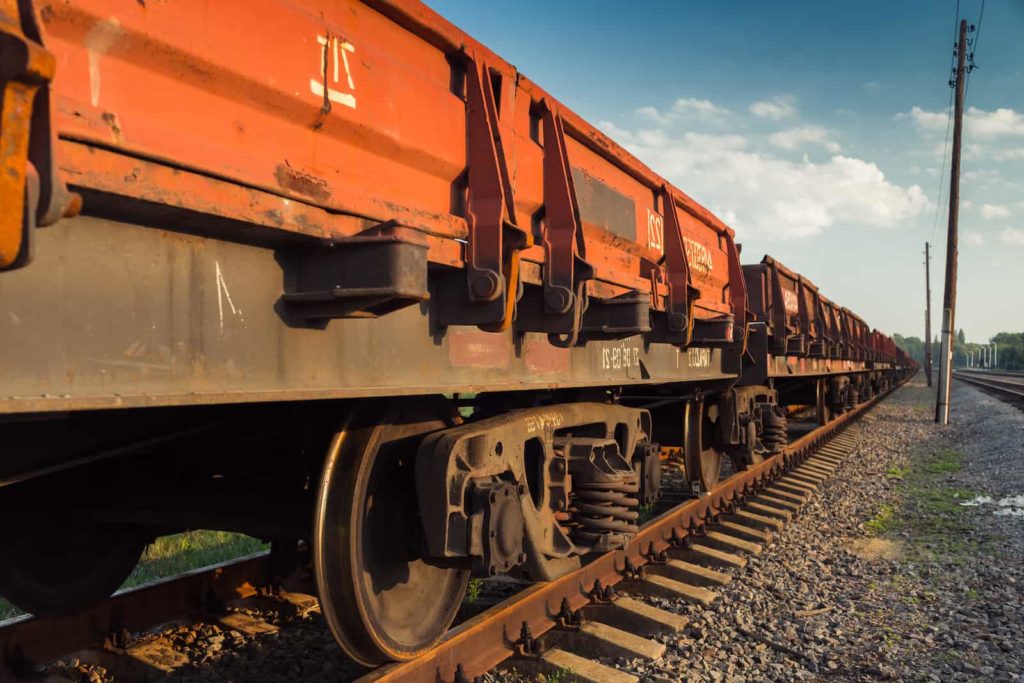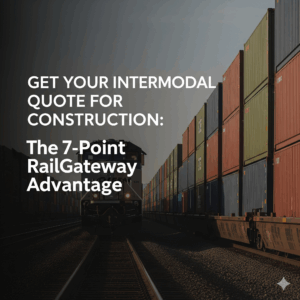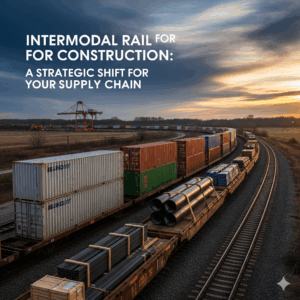This post was last updated on May 22nd, 2025
In the dynamic world of logistics, intermodal cargo continues to play a pivotal role in shaping supply chain success. As we navigate through 2025, businesses are increasingly turning to containerized intermodal cargo solutions to enhance efficiency, reduce transportation costs, and ensure the safe movement of goods across vast distances. The term intermodal cargo refers to freight that is transported using multiple modes of transport – typically rail, truck, and sometimes ocean – without handling the cargo itself when switching modes. This seamless transfer system is ideal for companies looking to simplify logistics while maximizing reliability.
Understanding which types of intermodal cargo are best suited for container shipping is crucial for effective planning. From packaged consumer goods and automotive parts to food products and electronics, there are numerous categories of cargo that thrive in an intermodal shipping environment. This guide will walk you through ten essential types of intermodal cargo that are not only reliable but also compatible with modern containerized shipping practices.
In today’s fast-paced supply chain landscape, flexibility and speed are non-negotiable. Businesses that utilize intermodal cargo solutions gain a competitive edge by accessing broader distribution networks, avoiding capacity shortages in trucking, and taking advantage of cost-effective rail services. Additionally, containerization helps reduce risks related to cargo damage and theft, making intermodal shipping one of the most secure logistics strategies available.
Moreover, the growing push for sustainability in logistics has positioned intermodal cargo as a smart environmental choice. By shifting freight to rail, which is significantly more fuel-efficient than road transport, companies can dramatically lower their carbon footprint. In fact, many organizations are setting sustainability targets that include measurable increases in their use of intermodal shipping.
As you explore this article, you’ll learn why these ten types of intermodal cargo stand out in today’s supply chain – and how leveraging the right cargo types can simplify operations, enhance performance, and contribute to greener business practices. Whether you’re a small enterprise shipping regionally or a multinational distributor managing cross-border transport, the reliability of intermodal cargo cannot be overstated.
Let’s dive into the core categories of intermodal cargo that are not only commonly shipped but proven to perform well in containerized transport:
- Packaged Consumer Goods
- Automotive Components
- Construction Materials
- Food and Beverage Products
- Paper and Packaging Supplies
- Textiles and Apparel
- Household Appliances
- Industrial Equipment
- Electronics and Technology Goods
- Agricultural Products
Each category offers specific advantages in terms of handling, protection, and cost when transported via intermodal cargo routes.
Industry Trends: How Intermodal Cargo Is Evolving in 2025
As demand for faster, greener, and more reliable shipping intensifies, the intermodal cargo sector is evolving to meet new market requirements. In 2025, several key trends are shaping how cargo is handled, transported, and tracked.
1. Sustainability Is Driving Mode Shift: Environmental responsibility is no longer optional. Shippers are increasingly choosing intermodal cargo to lower greenhouse gas emissions, reduce fuel usage, and meet ESG goals. Rail emits up to 75% less CO2 than trucks, making intermodal a preferred choice for sustainability-focused organizations.
2. Technology Enhancements in Tracking and Visibility: Digital transformation in logistics has introduced smart sensors, GPS tracking, and blockchain verification tools to intermodal cargo movements. These innovations provide real-time visibility and enhance security for every shipment, regardless of the number of transport modes involved.
3. Expanded Use of 53-Foot Containers: North America continues to favor larger containers to increase load volume per trip. This trend allows for improved cost-per-unit metrics and streamlines loading/unloading procedures, particularly when managing diverse intermodal cargo categories.
4. Integration with E-Commerce Fulfillment: With the rise of direct-to-consumer brands and rapid online shopping demands, intermodal cargo is being integrated into e-commerce logistics. Retailers are now using intermodal solutions to meet just-in-time delivery targets without over-relying on expensive last-mile trucking.
5. Collaboration with 3PLs and Forwarders: Partnerships with third-party logistics providers are strengthening in the intermodal cargo ecosystem. These experts help optimize container loads, select efficient routes, and manage complex cross-border transitions seamlessly.
6. Resilience and Risk Mitigation: The supply chain disruptions of recent years have taught companies the importance of diversified transport modes. Intermodal cargo offers resilience by allowing rerouting flexibility, especially when road transport is hindered by labor shortages or weather events.
As these trends continue to unfold, intermodal cargo will not only become more relevant but also more strategic for businesses aiming to thrive in a competitive global market.
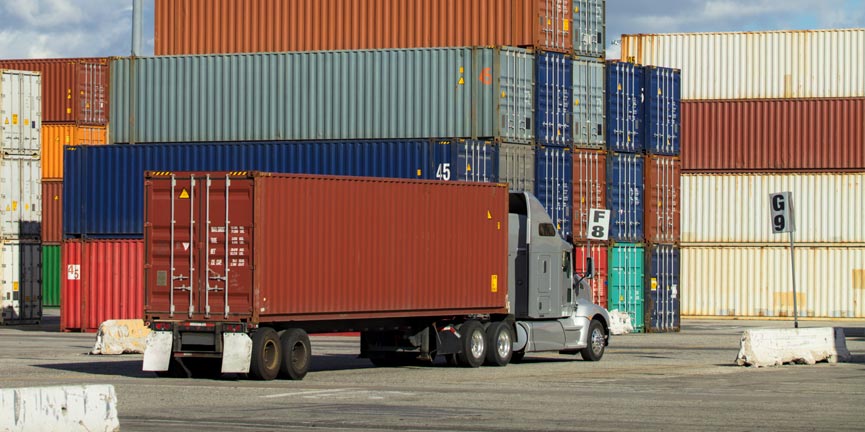
Types of Intermodal Cargo
Consumer goods
This is one of the most common types of intermodal cargo that can be shipped in an intermodal container.
This is because it does not have any special requirements, possibly long expiration dates, come in large quantities, and can be carried by land, sea, or rail, depending on your company’s origin.
Rail intermodal shipping is a popular way to transport consumer goods straight to the retailers’ shelves.
Fresh produce intermodal cargo shipping
Fresh products are also a type of cargo that can be shipped through an intermodal service.
Potatoes, onions, lettuce, it’s possible to use an intermodal cargo shipping model for delivering fresh produce. However, some companies might have to use refrigerated or temperature-controlled containers for some types of consumables.

Frozen products
Thanks to refrigerated intermodal cargo containers, frozen products can also be shipped via rail service.
So, if you are looking to transport frozen products through intermodal cargo shipping, make sure the container is specifically designed for that type of cargo.
If not, your goods might be susceptible to heat damage, impacting their quality and representing a considerable loss.
Shipping vehicles via intermodal cargo
Another type of intermodal cargo that can be shipped in intermodal containers concerns vehicles.
It is possible to use the railroads for shipping cars, scooters, and more from one place to another.
Therefore, international shipping of cars from overseas to the United States or Canada is a popular way for importers to bring their vehicles into North America while minimizing transportation costs for large amounts.
Liquids freight
You probably guessed that liquids freight is also a type of cargo that can be shipped thanks to intermodal transportation.
Intermodal rail shipping is used for this kind of cargo because tank containers are designed to carry liquid bulk from petrochemicals to corn syrup!
Large items and heavy machinery shipping
Another intermodal freight that can fit this type of shipment is the category of large items and heavy machinery.
This can include construction or agricultural machinery, specific vehicles, wind turbine blades, and so on.
These machines are usually large and heavy, making it quite challenging to find a way to transport them by land or air.
However, the containers are usually large enough for many of these items, explaining why intermodal freight transportation is a more fitted and safer solution.
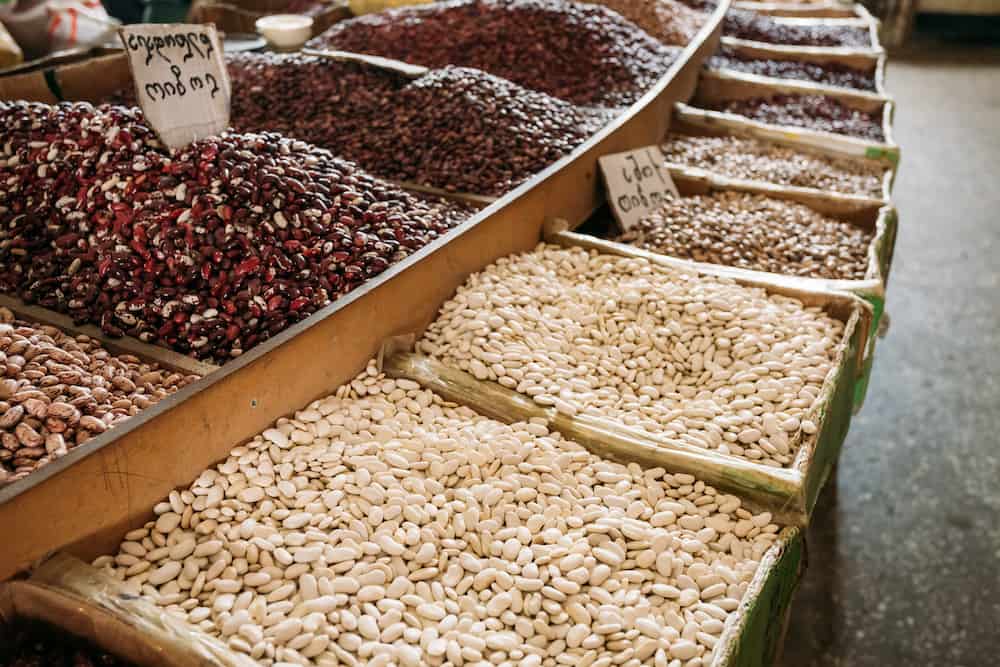
Dry bulk cargo shipment
Dry bulk cargo represents unpackaged raw materials such as wood logs, sand, gravel, or iron ore that can be sent through intermodal transportation.
This is a great and cost-effective solution for cross border freight shippers that need to send a high quantity of these types of goods across countries.
Common goods intermodal transportation
As the name suggests, these products do not have special requirements for transportation and can fit into ordinary freight containers while still meeting their weight or size limits.
We are talking about home appliances, clothes, toys, and more, sent in large quantities.
Industrial and construction materials
If you are a distributor of industrial and construction materials, intermodal transportation can be an excellent shipping strategy for your supply chain.
Pipes, metals, paper, bricks, but also large metal coils that usually need to stay in their original size while being transported across countries would not always fit into standard containers or small trucks.
It is also a risky shipment to manipulate during the load and unload process. Intermodal transportation allows teams to move goods effectively and safely with minimal handling.
To ease business logistics, railroads can then be an exciting alternative.

Hazardous materials intermodal shipments
Dangerous goods are a type of cargo that can be transported via intermodal rail routes in specialized containers and requires the assistance of trained personnel to handle them during transportation, loading, or unloading.
This kind of load also needs special permits from government agencies such as the Department of Transportation (DOT) or The Transportation Safety Board of Canada (TSB).
Be aware that you’ll have to pay an extra intermodal accessorial charge to cover the risks of the shipper and the paperwork required.
Fast-FAQ on Intermodal freight transportation
If you are unfamiliar with intermodal transportation, here are a few elements to understand about this freight shipping option.
What is intermodal freight shipping?
It’s a transportation model that allows shipping a large number of goods with two or more modes of transportation, including trains, trucks, or ships.
What is the intermodal shipping process?
The intermodal process begins with the cargo being loaded in an intermodal container, which is then moved through different modes of transportation from the pickup point to the final delivery.
Usually, the intermodal container is loaded on a truck and brought to an intermodal ramp, where it will be transferred onto a flat car or well car and then shipped by train for the long haul until the final destination. It might also be carried to other intermodal ramps if the container must be transferred to another type of intermodal carrier for the next stages of its journey.
The carrier uses specific containers designed to transport goods on the railway system, ships, or trucks. The cargo will stay in the same container all the way and won’t be unloaded/reloaded until the container arrives at its destination.
Why use intermodal freight transportation?
The main advantage of intermodal shipping is that it is a great, cost-effective way to ship a high quantity of consumer goods long-distance at a reduced cost.
Indeed, intermodal providers offer very competitive rates compared to aerial transportation or a 100% truck transit.
Intermodal freight transportation can also be more environmentally friendly and help your business lower its carbon footprint. Indeed shipping containers through rail transportation shows better fuel efficiency and reduces the number of CO2 emissions.
It also offers a more secure way to transport your goods. The merchandise will be less exposed to theft or damage as the containers remain closed.
How is the rail intermodal traffic nowadays?
Due to its numerous advantages, intermodal shipping has become a significant part of the transportation landscape in North America.
In the United States, according to the Association of American Railroads, rail traffic has been growing since 1997. It even broke a record in October 2020, during a global pandemic.
What cargo can’t you ship?
We’ve some common types of cargo you can ship, but what can’t you?
Personal belongings, shipments for household goods, or private vehicles are services unavailable with RailGateway.
This service is also unavailable for transporting human beings or pets.
As you can see, most cargo can be shipped through freight railroads, except for a few items or situations.
Whether you want to ship raw materials, common, frozen, and fresh goods, construction products, or even hazardous materials – there’s a container for it. Are you interested in making the switch over to intermodal? Don’t hesitate to contact us!
Conclusion
The logistics environment of 2025 requires companies to think bigger, smarter, and greener. Mastering the nuances of intermodal cargo shipping provides a unique advantage, allowing organizations to control costs, improve transit security, and meet sustainability commitments – all while scaling operations efficiently.
Embracing intermodal cargo is not simply about moving goods; it’s about transforming the way your business manages supply chains. The ten categories highlighted in this guide are just the beginning. With the right tools, strategies, and partnerships in place, intermodal shipping can deliver measurable improvements in delivery timelines, customer satisfaction, and overall profitability.
For businesses looking to streamline shipping within and beyond Canada, intermodal cargo delivers a balance of speed, flexibility, and dependability. And with container compatibility and advanced logistics tech at your fingertips, you can tailor each shipment to meet your exact needs – no matter the industry or cargo type.
In conclusion, whether you’re shipping food-grade goods, industrial equipment, or retail merchandise, intermodal cargo is your key to unlocking a smarter, more sustainable supply chain. Take these insights, analyze your logistics requirements, and start building a resilient intermodal strategy today.
FAQ
1. What is intermodal cargo?
Intermodal cargo refers to freight that is transported using two or more modes of transportation – typically rail, truck, ship, or even air – without the need to unload the cargo between transfers. The cargo stays in the same standardized container, ensuring a seamless and secure transition between carriers. This method is a cornerstone of modern supply chain efficiency, especially for long-haul and international shipments.
2. Why is intermodal cargo more efficient?
Intermodal cargo streamlines the shipping process by reducing manual handling and minimizing transfer delays. It allows containerized freight to move easily between trucks, trains, and ships with minimal disruption. This results in faster transit times, fewer touchpoints, and reduced risk of damage or loss.
3. Is intermodal cargo suitable for perishable goods?
Yes, intermodal cargo is highly suitable for perishables when shipped in refrigerated containers, also known as reefers. These containers maintain temperature control throughout the journey, whether by truck, rail, or sea. As long as the cold chain is maintained, goods like produce, meat, and pharmaceuticals can be safely shipped long distances.
4. How does intermodal cargo improve supply chain sustainability?
Intermodal shipping uses fuel-efficient transport modes like rail and ocean freight, which significantly lowers greenhouse gas emissions compared to over-the-road trucking. By reducing reliance on long-haul diesel trucks, businesses can meet their ESG goals and reduce environmental impact. This makes intermodal a more sustainable shipping option for eco-conscious brands.
5. What types of containers are used for intermodal cargo?
The most common containers include standard 20-foot and 40-foot ISO containers, high cube containers for bulky goods, refrigerated containers (reefers) for temperature-sensitive cargo, and flat racks for oversized equipment. Each container type is designed to be compatible across various transport modes. This flexibility helps optimize shipping capacity and load efficiency.
6. Are there size limits for intermodal cargo?
Yes, intermodal cargo must conform to container size standards to ensure compatibility across trucks, trains, and ships. Most cargo is shipped in containers ranging from 20 to 53 feet, with restrictions on weight, height, and width. However, special equipment like flat racks and open-top containers allow for some variation depending on the shipment.
7. Can intermodal cargo be tracked?
Yes, most intermodal freight can be tracked in real time through GPS and logistics platforms provided by carriers or 3PLs. This visibility allows shippers to monitor container location, transit milestones, and potential delays. Advanced tracking systems improve supply chain transparency and enhance customer service.
8. What are the risks of intermodal cargo shipping?
While intermodal shipping is generally reliable, risks include delays at transfer points, customs clearance issues, and handling damage. These risks are mitigated by proper documentation, secure packaging, and working with experienced logistics partners. Overall, the controlled environment of intermodal terminals reduces many of the risks common in road-only freight.
9. How are customs handled with intermodal cargo?
Customs clearance for intermodal cargo typically occurs at international border crossings or seaports, depending on the route. Shippers must ensure all required documents – such as bills of lading, invoices, and certificates—are accurate and submitted on time. Failure to comply can result in costly delays, fines, or seizure of goods.
10. Is intermodal cargo cost-effective for short hauls?
Intermodal shipping is most cost-effective for long-distance shipments, usually over 500 km, but can still offer value in regional corridors with nearby rail terminals. Urban areas with robust intermodal infrastructure are seeing increased use for shorter routes. Businesses should analyze their lane density and terminal proximity to determine cost efficiency.
11. What industries benefit most from intermodal cargo?
Industries that move large volumes of freight – such as retail, automotive, agriculture, construction, and consumer goods – see the most value from intermodal shipping. These sectors often rely on predictable schedules, lower transport costs, and reliable capacity. Intermodal helps them meet distribution needs while improving logistics resilience.
12. Do I need a freight forwarder for intermodal cargo?
While it’s not mandatory, many businesses work with a freight forwarder or 3PL to simplify the complexities of intermodal shipping. These partners handle coordination between carriers, manage documentation, and provide real-time tracking. This allows shippers to focus on core operations while ensuring smooth cargo transitions across modes.
How We Can Help
For businesses looking to optimize their freight shipping with reliable, efficient, and cost-effective solutions, RailGateway.ca is your trusted partner in intermodal logistics. Whether you’re new to freight trains or want to enhance your existing supply chain, our team of intermodal experts is ready to guide you every step of the way.
Contact RailGateway.ca today for a free quote or to speak directly with one of our experienced intermodal specialists. Let us help you unlock smarter, smoother shipping solutions tailored to your unique needs.
Visit RailGateway.ca or call us to get started on transforming your freight shipping strategy in 2025 and beyond.

